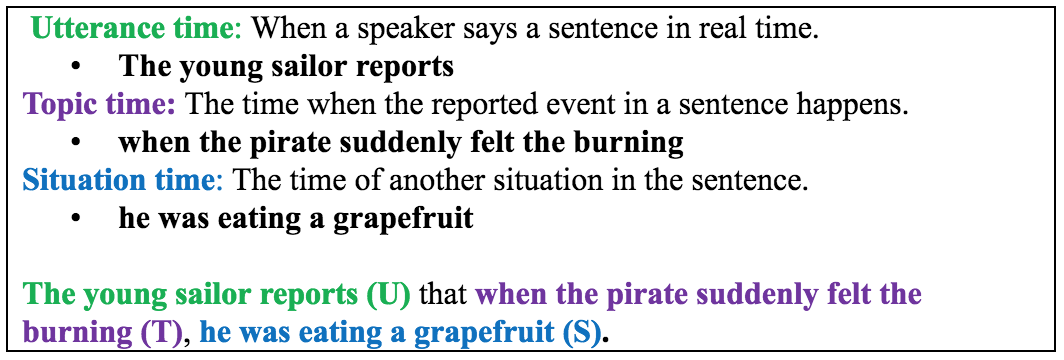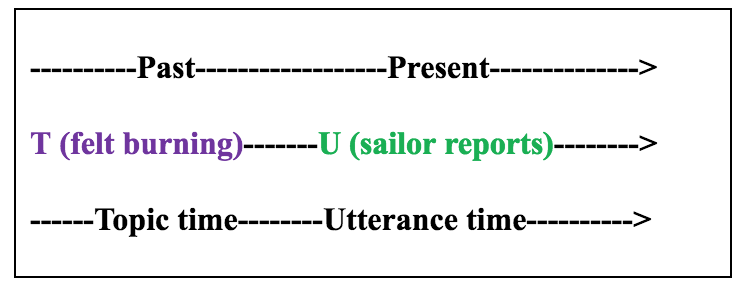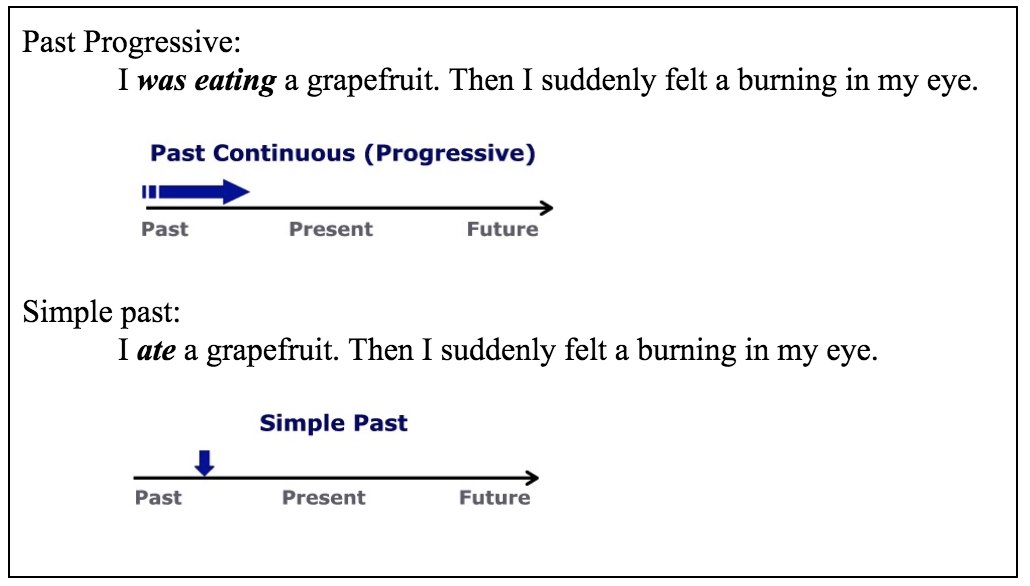In this article, Dr. Andreas Schramm draws on the research of his graduate students, colleagues, and from his own recent sabbatical to describe what makes the tense-aspect system in English notoriously challenging to teach and learn, and to show that it can nonetheless be explicitly taught. Drawing from his experience as an English learner and one-time English teacher in training, he shares anecdotes and practical tips to help English as a Second and Foreign Language teachers unpack the meaning of tense and aspect for their learners.
Past and Progressive walk into a bar. It was tense.
But the rest of the story is that it was not only tense. Aspect was also involved – which can be more dizzying than whatever else you might order at the bar. While tense refers to past, present and future, aspect expresses other time meanings and relationships, sometimes subtle, making it notoriously challenging to teach and learn, yet critical, because it shows up in every sentence. This was evident in one of my own early English lessons in my German high school. My teacher tried her hand at distinguishing “The sun was shining” versus “The sun shone.” Her explanation went something like this: “The first means that we could see it right then. The second means that it was shining yesterday.” Needless to say that I was a bit puzzled, not to mention that she was probably one of the only people I have ever heard use the word “shone.”
Teaching aspect is also challenging for native speaker teachers, who may find themselves resorting to contrived explanations that always seem to have exceptions. Teachers may contrast the simple present with present progressive by explaining that something happens regularly (“I shop every Monday”) as opposed to it happening right now (“I am shopping right now”). But what about “I live in St. Paul” vs. “I am living in St. Paul,” in which the latter also refers to some regular state of affairs, but somehow more temporary? Similarly, teachers may explain that we don’t use the progressive with emotions, such as “I love it,” but then comes along the McDonald’s commercial announcing, “I’m loving it!” Textbooks can also play a role in confusing the issue. While they offer explanations that can be useful for learners, from my observations, they often oversimplify. Teachers benefit from a more nuanced understanding of aspect, so that they don’t run into trouble when trying to teach it using textbooks.
A long time ago in Germany, I was also on track to become an English teacher. In part because German expresses aspectual meaning differently than English, I wrestled with the progressive in English until becoming a linguist. Fortunately, your students can begin to unpack the meaning of aspect in English – without becoming linguists. By first presenting prior research literature and then describing three studies conducted by my graduate students, research partners, and myself, this research-based discussion will hopefully help you become a better “applied linguist” when it comes to tense and aspect, and will show how explicit instruction can help adult English language learners understand the meaning of aspect, specifically, past progressive and simple past.
What Prior Research Teaches Us
To set the stage for understanding this research, and to address some of what makes aspect so challenging to teach and learn, this section will describe the literature around two types of aspectual meaning in English, referred to in this article as grammatical and situational aspect. To explore the teaching and learning of aspect in English, it will then describe the literature around aspect acquisition. It will then address the question of implicit versus explicit teaching.
Tense and Aspect in Verbs (Grammatical Aspect)
For me, it all got started with a seminal article by the linguist Paul Hopper (1982). I already knew that the meaning of the progressive versus simple past (grammatical aspect) in English was complex. In this article, Hopper explains how in narratives, the plot (he calls it the foreground) is expressed in the simple past, while the setting and scenery (his background) is expressed in the progressive. This went beyond tense, or just past, present and future. It was time (no pun intended) that I understood tense and aspect.
One way to explore the meaning of grammatical aspect is through narratives. We know that good narratives have a plot that causally connects all situations (e.g., van den Broek, 1988). The use of tense and aspect is one of the ways we create such causal connections in narratives. To explore this, let’s look at the short narrative below (adapted from Kivimagi (2013).
An old pirate was sitting in the bar. He was smoking a pipe and drinking a glass of rum. He was wearing an eye patch, and he had a parrot on his shoulder and a wooden leg. Instead of his right hand, he had a metal hook. A young sailor was chatting with the pirate and he ASKED him about his adventures at sea.
‘So, how did you lose your leg?’, the young man ASKED the pirate.
‘Arrr!,’ SAID the pirate, ‘You see, some sharks were circling the ship when I FELL overboard. Luckily, my men PULLED me back onto the ship before the sharks ATE me completely, but one of the sharks GOT my leg.’
‘And how about the hook on your hand? How DID you lose your hand?’
‘I was boarding a ship when another sailor CUT OFF my hand with a sword.’
‘That’s amazing! What a life full of adventures!’ SAID the young man. ‘And how about your eye? How did you lose that?’
‘I was eating a grapefruit when I suddenly FELT a burning in my eye.’
‘But I don’t understand. How DID you lose your eye?’
‘Arrr!’ SAID the pirate, ‘it WAS my first day with the new hook.’
When the pirate was eating the grapefruit, presumably, the burning was caused either by the grapefruit squirting into the pirate’s eye or by the pirate accidentally rubbing his eye with his new hook. So what is the difference if we change “was eating” to “ate” in the highlighted sentence? What were the reason(s) for the burning? When we change “was eating” to “ate,” the reason must be something else, no longer connected to the grapefruit. The grapefruit is gone, so it couldn’t have caused the burning. Perhaps a piece of dust flew into the pirate’s eye.
To understand what happens when we change “was eating” to “ate,” let’s look at the time periods in this story. There are three time periods in this and in any sentence: the utterance time, topic time, and situation time (see Figure 1).

The difference between tense (present, past, future) and grammatical aspect lies in the different relationships between these three time periods (Klein, 1994). Tense is determined by the relationship between the time of speaking (U) and the time of the events in a story plot (T).

In the sentence in Figure 2, the tense is past, because the utterance time refers to a topic time that came before it (see Figure 2).

When grammatical aspect is used, the relationship between the time of events in the plot (T) and the time of some other situation (S) matters (see Figure 3).
There are different kinds of relationships in the past progressive and simple past. In the progressive, only part of the situation is emphasized.

Its beginning and end are excluded. The situation is uncompleted, or imperfective. The grapefruit is eaten only partly (See Figure 4).
In the simple past, the relationship is different. The situation is completed, or perfective. The end point of the eating is emphasized. What can be tricky here is that we typically talk about the simple past as a tense, but it also doubles up as a perfective aspect. It is a tense in that it refers to the past, but it is also a perfective aspect in that it emphasizes that the grapefruit is gone; only the peel is left (see Figure 5).

When a situation is completed, or perfective, there is another possibility: some time has passed since the situation’s completion. That is the case in the present and past perfect, which is beyond the scope of this article but can be further explored in Klein (1994).
Tense and Aspect in Sentences (Situation Aspect)
Now that we have tackled grammatical tense and aspect, I have to admit that there is another sticking point. Time is not only indicated on the verb through tense and aspect. Different kinds of time periods are also inherent in sentences. Look at the following sentences. Each sentence appears to express a situation with a longer time period than the previous:
- Pat walked to the park.
- Pat walked in the park.
- Pat was tall.
The differences in the time periods of these three sentences has to do with situation aspect (Vendler, 1957). We can use three descriptors to label these differences: 0-state (Pat was tall), 1-state (Pat was walking in the park), and 2-state (Pat was walking to the park) because of the time periods (=states) involved in each (Klein, 1994). Let me give you examples and reasons for each of them below.
The Three Situation Types
0-state: refers to situations that don’t have a beginning or end point.
They express permanent properties. For example, “Pat is tall” is a 0-state situation. There is no time when she changes from tall to not tall or is not tall (except her childhood, which is irrelevant for such a statement). By contrast, the sentence “Pat walked in the park” has a beginning point, at which she is getting into the park, and an end point, when she gets out of the park again.
Test: A good test for 0-state situations is to use an adverb that gives a time limit. There should be, and indeed is, a clash: “Pat is tall for two hours.”
1-state: refers to situations having a beginning and an end point.
The sentence “Pat walked in the park” has such endpoints: the beginning and end of the walk. There were many times in her life when she was not walking and will not be walking.
Test: As a test, we can easily say “Mother walked in the park for two hours.” There are plenty of times before and after Pat’s two-hour walk when she is not walking. This is different from her being tall when there aren’t such times during which she isn’t tall.
2-state: refers to whether a situation has a before and after contrast.
There is an endpoint of one state and the starting point of another.
The sample sentence “Pat walked to the park,” for example, has the logical or natural endpoint of getting to the park. It expresses a contrast between the state, or time period, before getting to the park and the state of after having gotten there. It is a 2-state situation.
Test: We determine whether an event has two states (i.e., has a natural endpoint of the first state) by applying the following test question (Garey, 1957): “If Pat was walking to the park and was interrupted while walking to the park, has she walked all the way to the park yet?” If the answer is “no” (she has not gotten there yet), the contrast between the states (endpoint of the first state) has not been expressed. Therefore, the situation must have two states.
By comparison, if we take the 1-state situation “Pat walked in the park,” and we apply this test, the answer will be “yes.” See for yourself: “If Pat walked in the park and was interrupted while walking in the park, has she walked in the park yet?” Certainly we can say that Pat has walked already (even if she hasn’t finished her walk). This situation does not have a before and after contrast and is therefore not a 2-state situation.
No wonder it’s difficult to learn aspect! It is challenging to understand it, and therefore to explain and teach. The explanation given above helps explain the oddity of the well-meaning English teacher’s explanation of “The sun was shining/ The sun shone.” Using the simple past in “The sun shone” implies a before and after contrast characteristic of the perfective. Because “shine” is a 0-state verb, without a clear beginning or endpoint, this before and after contrast is awkward. Similarly, this sheds light on why the explanation that “we use the simple present to talk about habitual actions and the progressive for actions taking place ‘right now’” sometimes works, and sometimes does not. It works with 1-state verbs with a clear beginning and end point, such as “shop.” We can confidently explain to learners that we use the simple present, “I shop (every week)” to describe a habitual action and “I am shopping” to describe an action happening right now. However, this explanation breaks down with 0-state verbs. As we saw in the introduction, it doesn’t work well to distinguish “I live in St. Paul (every week)” vs. “I am living in St. Paul (right now)” because in this sentence, “live” functions as a 0-state verb. It has no endpoints and expresses a longer time period than a 1-state verb. Thus it works just fine to use either the simple present “I live in St. Paul” (=permanently) or the progressive “I am living in St. Paul” (=temporarily). We will next talk about learning aspect and teaching it.
Acquisition of Aspect in English
In teaching aspect, we must also consider the learner and her stage of tense-aspect development. In the earliest stage of tense-aspect acquisition, the pragmatic stage (Meisel, 1987), a learner relies on extralinguistic resources (e.g., conversational turns). This learner also relies on a universal ordering principle of events, telling events in the order in which they happened. Next, in the lexical stage, learners employ time adverbials and connectives (e.g., “before,” “and then”) so she does not have to rely on the universal order of events. In the final stage, the morphological stage, time content is expressed by successively refining the grammatical tense-aspect system alongside adverbials.
In the morphological stage there is another challenge. The use of morphological forms also changes with each communicative task (von Stutterheim & Klein, 1989). For example, in recounts, main events are in the past tense, while less important events are backgrounded using the progressive. And in academic writing, the present signals agreement with a statement, past indicates disagreement, and present perfect means partial agreement (Schramm, 1996). Thus, verbal tense-aspect forms have to be redefined, and thus relearned, within each new context, especially considering that aspect use is distributed unevenly across contexts, such as using the progressive with emotions or politeness (Römer, 2005), e.g., “I’m feeling great” or “would you be willing”. Some researchers therefore use the “meaning-oriented approach” to study language acquisition, which investigates meanings and their associated forms (Bardovi-Harlig, 2014). This approach has yielded the developmental insight that language learners first use perfective aspect together with 2-state situations (Pat walked to the park) (Aspect Hypothesis; e.g., Andersen & Shirai, 1996) for discourse foregrounding (e.g., describing the plot) (Interlanguage Discourse Hypothesis; e.g., Bardovi-Harlig, 2000). Only later do they use imperfective aspect connected with 1-state situations (Pat is walking in the park) for backgrounding (e.g., describing setting and scenery). This meaning-oriented approach has also been the backdrop for our research. And, while much second language aspect research focuses on production (e.g., Andersen & Shirai, 1996), we focus on reading comprehension to emphasize understanding the meaning of aspect.
Learners’ first languages also must be taken into consideration in the acquisition of aspect. Some languages have morphosyntactic markers (visible markers on a word or in the structure of a sentence) for aspect, while others do not. English, for example, uses morphological endings (-ed, -ing) and syntactic phrases involving a form of be or have in the expression of aspect, as in “was eating.” In our study of Arabic learners of English (Schramm & Mensink, 2016), speakers of a language without morphosyntactic aspect, learners were found to struggle with aspectual meanings within English narrative texts. While a following study of Spanish speakers (Riddle, in press) found similar struggles among native Spanish speakers after finishing reading English narrative texts, it also found that while reading, Spanish speakers’ understanding of aspect resembled young adult native English readers (Becker, Ferretti, and Madden-Lombardi, 2013; Schramm & Mensink, 2016). The latter was not evident in Arabic speakers and may be due to transfer from Spanish.
Explicit and Implicit Teaching
Our research has taken an explicit approach to teaching aspect. Thus, it is helpful to understand explicit and implicit teaching in Second Language Acquisition (SLA). The role of input has been a central concern in SLA research for over 40 years (e.g., Han & Tarone, 2014). Successful language acquisition appears to require a combination of implicit and explicit instructional input. Grammar-oriented form-focused instruction and communicative language teaching need not be mutually exclusive (e.g., Nassaji, 2000). In fact, most teachers value the practice of blending these approaches because it elicits, enhances, and combines the grammatical and sociolinguistic aspects of language (e.g., Long, 1991; Swain 1995).
Several strategies have been proposed to combine implicit and explicit instruction through input enhancement, or intervention used to direct learners’ attention to language forms (Sharwood Smith, 1991) and thus raise learner consciousness of the input. One of them is textual enhancement, which is an approach that combines implicit communicative and explicit form-focused input by embedding typographical cues such as highlighting in texts (Rutherford & Sharwood Smith, 1985). The goal is to increase learners’ likelihood of paying attention to relevant features of second-language input. In our research, we combine input enhancement with explicit teaching alongside meaningful communication (Long, 1991) to draw learners’ attention to and notice targeted linguistic forms and their meanings (e.g., Leow, 2015). Here is what one of the enhanced texts from instructional interventions in our research looks like.
Table 1. Experimental Text for “Scary Trip to the Grandparents”
1 Shelley was visiting her grandparents in Northern Minnesota.
2 It was a beautiful drive,
3 the narrow two-lane road lined with trees,
4 leaves beginning to turn.
5 The road was empty except for this slow poke in front of her.
6 Impatiently, she PASSED/was passing the pickup.
7 Unexpectedly, a deer came charging out of the woods
8 forcing her to yank the steering wheel to the right.
9 Within split seconds, several thoughts raced through her head.
10 The car belonged to the company her dad works for.
11 Would she get in trouble for taking it without asking?
12 Would he punish her by not letting her use his car again?
13 She felt a strong bump.
In a study using implicit instructional interventions with college prep learners with mixed first languages, when no textual enhancements were used, learners appeared not to notice the meaning of aspect (Schramm, 2012). By contrast, when using textual enhancements of aspectual forms with texts like that pictured to the left, textual enhancement appeared to prompt awareness of aspectual meanings among university freshmen non-native English speakers (Meidal, 2008). Learners in both of these studies presumably were on the morphological stage of acquiring tense-aspect meanings (Meisel, 1987). Thus textual enhancement may be a possible teaching strategy at this developmental stage for triggering noticing of aspect. Further studies combining textual enhancement with explicit teaching are described below.
Research-Based Practices
This section will summarize the major findings of three successive studies conducted by advisees, research partners and myself. These studies and related materials can be viewed on my website by early 2018 (https://works.bepress.com/andreas-schramm/).
Two of these studies were Midwestern classroom studies conducted by my graduate students. Sample sizes were relatively small, and first languages were mixed. The third carefully controlled, large-scale follow-up study was conducted during my recent sabbatical in Germany with 91 participants and first language accounted for. Two German colleagues and myself conducted this study with design and statistical support from a U.S. colleague.
All three studies found that adult English language learners who were presumably on the morphological stage of aspect acquisition (based on their English proficiency and information from their instructors) showed an overall increased understanding of the causal meaning of the progressive (imperfective) aspect in sentences like sentence (6) in Table 1 after one explicit teaching intervention. Additionally, the final large-scale study found that understanding increased not only when reading narratives with causes and surprise effects (as in Table 1), which were the vehicle for teaching this meaning in the intervention, but also in a general way (with shorter narratives without surprise effects).
Three Studies with Causes and Surprise Effects
In each of these three studies, conducted by Kivimagi (2013), Wytaske (2016), and Schramm, Haser, Mensink & Reifenrath (2017), narratives like in Table 1 were used in a teaching intervention. Readers needed to draw causal inferences by understanding the completed or uncompleted meaning of aspect. To draw readers’ attention to those aspectual meanings and forms, they were text-enhanced with color and highlighting. In each narrative, there were two possible causes and a single surprise-effect. Examples of causes included, (6) “Impatiently, she was passing the pickup” and (7) “Unexpectedly, a deer came charging out of the woods.” An example of a surprise-effect was, (13) “She felt a strong bump.” Depending on the grammatical aspect of the verb in the first cause situation – past progressive (was passing) or simple past (passed), readers needed to infer the most likely cause. In each study, we tracked learners who chose a cause in the past progressive rather than the simple past as having better understood the aspectual meaning, because the incomplete meaning of the progressive makes it a more likely cause. That is, “Impatiently, she was passing the pickup” is a more likely cause for the effect, “She felt a strong bump” than “Impatiently, she PASSED the pickup.”
Not only grammatical aspect, but situation aspect was controlled in the stories. They were designed to consistently use causal sentences with 2-state situation aspects that have explicit endpoints. Because of their emphasis on before and after contrast, 2-state verbs are most clearly uncompleted in the past progressive and most clearly completed in the simple past.
The Questions. Each of these three studies investigated whether explicit instruction of aspectual meaning as related to causal inferencing, combined with textual highlighting, could help learners make causal inferences based on aspect in narrative texts.
The Settings. The first two studies took place in Midwestern classrooms – college and Adult Basic Education (ABE) – with adult learners. The third large-scale study took place at a large public university in Germany.
The Participants. Participants in the Midwestern classroom studies were all adults who had English proficiencies of at least 80 on the IBT/TOEFL (L. Beling, personal communication, November 2011) or a reading proficiency of at least a 5.0 and a language proficiency of at least a 4.5 on the Test of Adult Basic Education (between fourth and fifth grade in the K-12 educational system). Participants in the second study ranged in age from 25 to 61 and represented the following native languages: French, Vietnamese, Telugu, Spanish, Nepali, and Chinese. This information was not tracked in the first study. The 91 participants (60 instructed; 31 uninstructed) in the German study were native German-speaking novice teacher candidates of high-advanced English proficiency (TOEFL 500-550).
The Teaching Interventions. All three studies used a variation of the following procedure. Differences between the procedures had to do with how many texts were used in the pre-test, guided practice, and post-test, ranging from three to eight in each. The materials used to complete these studies can be viewed here: https://works.bepress.com/andreas-schramm/27/.
The teaching interventions (detailed here: https://works.bepress.com/andreas-schramm/28/) followed this basic procedure:
- A pre-test was administered.
- Students were instructed in
- aspect,
- causal inference generation in narratives, and
- identifying the textual enhancements.
- The second and third items involved three steps:
- modelling,
- guided practice, and
- independent practice.
- Finally, the students took the post-test.
During the grammar instruction each study presented an explicit grammar lesson on the meaning of imperfective and perfective aspect. These lessons consisted of a metalinguistic explanation of aspect focusing on the perfective and imperfective meanings themselves and their use in narratives.

They also included an explanation of textual enhancements. Students were taught that the perfective starts and ends, and that the imperfective starts and is not necessarily done. The lessons included graphs on the definitions of the perfective and imperfective. Examples of the graphs used are in Figure 6. The grammar instruction in the third study also used Figures 1-5 above.
During the modeling and guided and independent practice on how to use the perfective and imperfective in context, stories were used like the sample in Table 1. With the guided and independent practice, students received a narrative in either the perfective or imperfective aspect.
The Post-Test Data. All three studies collected post-test data from participants to measure acquisition of the imperfective causal meaning of progressive aspect. This post-test data was collected both during reading and immediately after participants finished reading the stories. The second and third study also collected additional data:
- Wytaske’s study (2016) collected additional post-test data 30 days after the post-test both while reading and immediately after participants’ finished reading to see if the new understanding of aspect was retained.
- Schramm & et al.’s (2017) large-scale German study collected delayed post-test data (as in Wytaske’s study), approximately four months after the post-test also both during reading and after participants finished reading. This delayed post-test data is still being evaluated and can be viewed on my website by early 2018 (https://works.bepress.com/andreas-schramm/).
The Findings. In all three studies, immediately after reading the stories, participants processed the causal meaning of the progressive, and therefore appeared to notice it, statistically significantly more than in the pre-test. Destabilization of this increased understanding also occurred while reading. Specifically:
- In Kivimagi’s (2013) study, while reading, destabilization occurred in what participants already knew, based on the pre-test, about the simple past.
- In Wytaske’s (2016) study destabilization of the imperfective meaning of aspect occurred after finishing reading stories 30 days after the instruction. It was still fairly good while reading. Thus her instruction improved the understanding of progressive aspect, but more strongly in the short term than in the long term.
- In Schramm et al.’s (2016) large-scale German study, during reading, participants’ understanding of the causal meaning of progressive aspect increased when compared to the pre-test. However, they also identified perfective situations as causes more than they identified imperfective (progressive) situations.
The destabilization in all three studies occurred while reading. This is not surprising since they were using cognitive short-term memory resources while reading (e.g., Magliano & Schleich, 2000). This destabilization is also predicted by the Aspect Hypothesis, which states that language learners first use perfective aspect together with 2-state situations like in our stories (e.g., Bardovi-Harlig, 2000). While this destabilization may appear to show regression, it is common – things often get “worse” before they get “better” during instruction of new information (Bardovi-Harlig, 2000).
While the delayed post-test data in my German study is still being analyzed, Wytaske’s (2016) delayed post-test data suggests that aspect acquisition, with just one intervention, decreased somewhat over time. Not surprisingly, repeated follow-up instruction seems required for a long-term change in reading.
My Sabbatical Study without Surprise-Effects
While we knew from the previous studies with narratives that learners were showing an increased understanding of the imperfective meaning of progressive aspect in the context of the two-cause surprise-effect narratives that we used in our instructional intervention, we also wanted to know if participants gained a more general understanding of the meaning of grammatical aspect after the intervention. Thus, in addition to collecting post-test data on the acquisition of the causal meaning of aspect, we used shorter versions of such stories, without surprise effects, to measure whether direct instruction improved general understanding of the imperfective (uncompleted) meaning of aspect.
In the pre-test, learners started out (and finished) with an overall strong understanding of the completed meaning of the perfective simple past. This follows the Aspect Hypothesis (because our study used 2-state verbs). In the post-test, after instruction, however, learners showed a greater increase in understanding of the uncompleted meaning of the imperfective (progressive) than the perfective meaning. This is counter to the Aspect Hypothesis, suggesting that the understanding of imperfective may not be set in stone, and can be impacted by direct meaning-based instruction.
It is important to note that the control group without meaning-based instruction also showed some increase in understanding of the perfective and imperfective meaning of aspect over the course of a semester, though significantly less. This is not surprising since presumably they received some instruction on aspect in their classes, but did not receive the explicit meaning-based instructional intervention. Results from this part of the study also suggest that the explicit meaning-based teaching in the intervention (Bardovi-Harlig, 2014) is effective compared to the presumably traditional, form-based teaching methods of the control group (e.g., Leow, 2015), based on anecdotal information from instructors and students about how aspect is typically taught. Thus, the impact of explicit meaning-based teaching on aspect development should be explored further.
Implications and Discussion
The meaning of progressive aspect (Klein, 1994) – in the first three studies, at least the causal meaning connected to its uncompleted nature (Schramm & Mensink, 2016) – appears possible to teach explicitly in meaningful contexts with successful initial understanding. This confirms the literature on explicit teaching alongside meaningful communication (e.g., Leow, 2015; Long, 1991; Nassaji, 2000). As we’ve also seen in the study without surprise effects, explicit, meaning-based teaching appears helpful for increasing general aspect understanding, supporting a meaning-based over a form-based approach to teaching aspect (e.g., Bardovi-Harlig, 2014).
For long-term understanding, more instruction over time seems to be required. Teaching aspect is not a one-time shot. It will require syllabus design that keeps cycling through the information and reinforcing it. While many studies focus on the production of aspect in English (e.g., Andersen & Shirai, 1996) – and this is important for adult English language learners who are studying English for Academic Purposes (Schramm, 1996) – these studies suggest that reading comprehension of aspect may be useful for acquisition (Schramm & Mensink, 2016). Since comprehension often precedes production (Towell, 2013), it may be good to first teach the meaning of aspect in the context of text-enhanced reading (Rutherford & Sharwood Smith, 1985).
When teaching aspect, keep in mind that things sometimes get “worse” before they get “better” and what appear to be temporary setbacks can be testimony to being in the process of learning (Bardovi-Harlig, 2000). The acquisition of aspect does not appear to be linear and may need sustained follow-up to stabilize. As we can see from these studies, all the nuances of aspectual meaning do not need to be explained to learners as part of explicit instruction for them to increase their understanding. Teachers can simplify explanations to fit their learners and contexts, knowing that their learners will likely never have to talk about sunshine being completed. However, by understanding more about grammatical and situational aspect (Klein, 1994; Vendler, 1957), teachers can be aware of the limitations of simplified explanations as well. Depending on learners’ needs, teachers may also want to explore in what contexts exceptions come up, such as using the progressive for politeness or with emotions (Römer, 2005), including to create a sense of immediacy (Swales & Feak, 2012), for example, in advertisements (“I’m loving it!”). A field trip to McDonald’s may be a great start!
References
Andersen, R. & Shirai, Y. (1996). Primacy of aspect in first and second language acquisition: The pidgin/creole connection. In W. Ritchie & T. Bhatia (Eds), Handbook of Second Language Acquisition (pp. 527-570). San Diego, CA: Academic Press.
Bardovi-Harlig, K. (2000). Tense and aspect in Second Language Acquisition: Form, meaning, and use. Malden, MA: Blackwell Publishers.
Bardovi-Harlig, K. (2014). Documenting interlanguage development. In Z.-H. Han & E. Tarone (Eds.), Interlanguage: Forty years later (pp. 127-146). Amsterdam: John Benjamins.
Becker, R. B., Ferretti, T. R., & Madden-Lombardi, C. J. (2013). Grammatical aspect, lexical aspect, and event duration constrain the availability of events in narratives. Cognition, 129(2), 212–220.
Garey, H.B. (1957). Verbal aspect in French. Language, 33, 91-110.
Han, Z. & Tarone, E. (2014). Interlanguage: Forty years later. Amsterdam: John Benjamins Publishing Company.
Hopper, Paul. (1982). Aspect between discourse and grammar. In P. Hopper (Ed), Tense-aspect between semantics and pragmatics (pp. 3-18). Amsterdam: John Benjamins.
Kivimagi, Cadi. (2013). Perfective and imperfect aspect acquisition in a narrative context in university ESL students using explicit instruction and textual enhancements. MA thesis, Hamline University, Saint Paul, MN. Retrieved from https://digitalcommons.hamline.edu/hse_all/505/
Klein, Wolfgang. (1994). Time in language. New York, NY: Routledge.
Leow, R. 2015. Explicit learning in the L2 classroom: A student-centered approach. New York & London: Routledge.
Long, M. H. (1991). Focus on form: A design feature in language teaching methodology. In K. de Bot, R. Ginsbert, & C. Kramsch (Eds.), Foreign language research in cross-cultural perspective (pp. 39-52). Amsterdam: John Benjamins.
Magliano, J. & Schleich, M. (2000). Verb aspect and situation models. Discourse Processes 29: 83-112.
Meidal, J. (2008). Noticing and grammatical aspect in ESL. MA thesis, Hamline University, Saint Paul, MN. https://digitalcommons.hamline.edu/hse_all/361/
Meisel, J. (1987). Reference to past events and actions in the development of natural language acquisition. In C. Pfaff (Ed.) First and second language acquisition processes (pp. 206-224). Cambridge: Newbury House.
Nassaji, H. (2000). Towards integrating form-focused instruction and communicative interaction in the second language classroom: Some pedagogical possibilities. The Modern Language Journal, 84(2), 241-250.
Riddle, H. (In Press). Aspect comprehension and processing in narratives by native Spanish speakers. MA thesis, Hamline University, Saint Paul, MN. https://works.bepress.com/andreas-schramm/5/
Robinson, P. (1996). Learning simple and complex rules under implicit, incidental rule-search conditions, and instructed conditions. Studies in Second Language Acquisition 18, 27-67.
Römer, U. (2005). Progressives, patterns, pedagogy: A corpus-driven approach to English progressive forms, functions, contexts, and didactics. Amsterdam: J. Benjamins Pub. Co.
Rutherford, W. and Sharwood Smith, M. (1985). Consciousness-raising and universal grammar. Applied Linguistics 6, 274-282.
Schramm, A. (1996). Using aspect to express viewpoint in EST texts. English for Specific Purposes 15, 141-164.
Schramm, A. (2012). Awareness during narrative comprehension and potential acquisition of aspectual meanings by non-native English speakers. Poster session presented at Society for Text and Discourse, Montreal. https://works.bepress.com/andreas-schramm/
Schramm, A., & Mensink, M. C. (2016). Processing of aspectual meanings by non-native and native English speakers during narrative comprehension. In O. Timofeeva, A. Gardner, A. Honkapohja, & S. Chevalier (Eds), New approaches to English linguistics: Building bridges (pp. 251-280). Amsterdam; Philadelphia: John Benjamins Publishing Company.
Schramm, A., Haser, V., Mensink, M., & Reifenrath, J. (2017). Cognitive processing of time in language by non-native readers: Can explicit teaching promote interlanguage development? Poster from 15th International Pragmatics Conference, Belfast. Retrieved from https://works.bepress.com/andreas-schramm/
Sharwood Smith, M. (1991). Speaking to many minds: on the relevance of different types of language information for the L2 learner. Second Language Research 7, 118-132.
Swain, M. (1995). Three functions of output in second language learning. In G. Cook & B. Seidlhofer (Eds.), Principle and practice in applied linguistics: Studies in honour of H. G. Widdowson (pp. 125-144). Oxford: Oxford University Press.
Swales, J. & Feak, C. (2012). Academic writing for graduate students: Essential tasks and skills. New York & London: Routledge.
Towell, R. (2013). Learning mechanisms and automatization. In J. Herschensohn & M. Young-Scholten (Eds). The Cambridge handbook of second language acquisition (pp. 114-136). Cambridge: Cambridge University Press.
van den Broek, P. (1988). The effects of causal relatedness and importance of story events. Journal of Memory and Language 27, 1-22.
Vendler, Z. (1957). Verbs and times. Philosophical Review 66, 143-160.
von Stutterheim, C. & Klein, W. (1989). Referential movement in descriptive and narrative discourse. In R. Dietrich & C. Graumann (Eds.), Language processing in social context (pp. 39-76). Amsterdam: Elsevier Science Publishers.
Wytaske, Christine. (2016). Aspect instruction and narrative inferencing. MA thesis, Hamline University, Saint Paul, MN. Retrieved from https://digitalcommons.hamline.edu/hse_all/4220/





